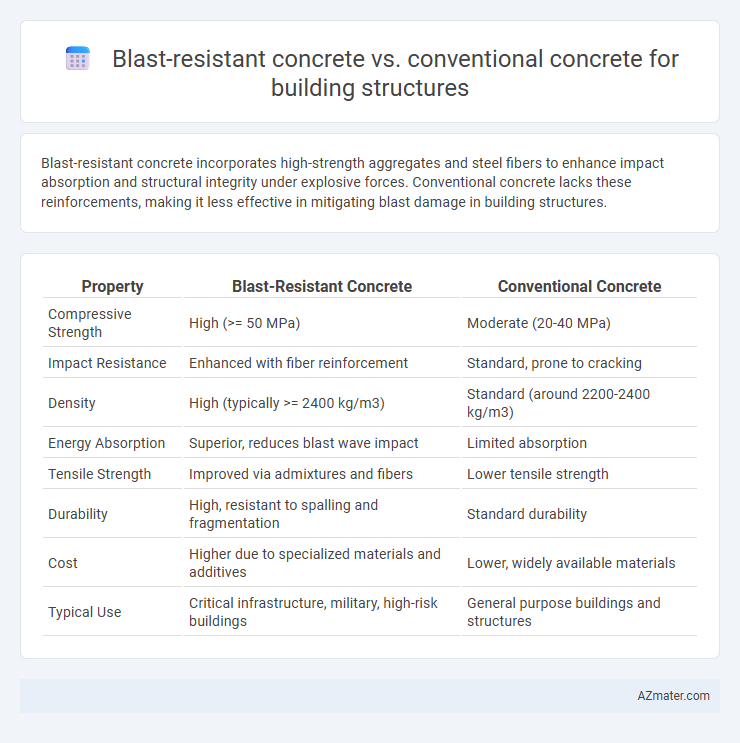Blast-resistant concrete incorporates high-strength aggregates and steel fibers to enhance impact absorption and structural integrity under explosive forces. Conventional concrete lacks these reinforcements, making it less effective in mitigating blast damage in building structures.
Table of Comparison
| Property | Blast-Resistant Concrete | Conventional Concrete |
|---|---|---|
| Compressive Strength | High (>= 50 MPa) | Moderate (20-40 MPa) |
| Impact Resistance | Enhanced with fiber reinforcement | Standard, prone to cracking |
| Density | High (typically >= 2400 kg/m3) | Standard (around 2200-2400 kg/m3) |
| Energy Absorption | Superior, reduces blast wave impact | Limited absorption |
| Tensile Strength | Improved via admixtures and fibers | Lower tensile strength |
| Durability | High, resistant to spalling and fragmentation | Standard durability |
| Cost | Higher due to specialized materials and additives | Lower, widely available materials |
| Typical Use | Critical infrastructure, military, high-risk buildings | General purpose buildings and structures |
Introduction to Blast-Resistant vs Conventional Concrete
Blast-resistant concrete incorporates high-strength aggregates and specialized fibers to enhance its energy absorption and reduce spalling during explosive impacts, providing superior structural resilience compared to conventional concrete. Conventional concrete primarily relies on a standard mix of cement, water, and aggregates, which offers adequate compressive strength but lacks the tailored properties needed to withstand blast loading effectively. Advances in material composition and reinforcement technology make blast-resistant concrete the preferred choice for critical infrastructure requiring enhanced safety against dynamic pressures and shock waves.
Key Properties of Blast-Resistant Concrete
Blast-resistant concrete demonstrates significantly higher compressive strength and enhanced energy absorption compared to conventional concrete, making it ideal for fortifying building structures against explosive forces. Its increased density and inclusion of specialized aggregates or fibers improve toughness and crack resistance, reducing structural damage during blasts. Additionally, blast-resistant concrete exhibits superior flexural strength and reduced spalling, ensuring greater integrity and occupant safety in high-threat environments.
Material Composition Differences
Blast-resistant concrete incorporates high-performance materials such as fiber reinforcements, polymer additives, and specialized aggregates to enhance energy absorption and fragmentation resistance, unlike conventional concrete which relies primarily on cement, sand, gravel, and water. The inclusion of steel or synthetic fibers in blast-resistant mixes improves tensile strength and ductility, significantly reducing spalling and cracking under explosive loads. Conventional concrete lacks these advanced composites, making it more susceptible to structural failure during high-impact or blast events.
Structural Performance Under Explosive Loads
Blast-resistant concrete incorporates fibers, polymer additives, and optimized aggregate gradation to significantly enhance tensile strength, energy absorption, and crack resistance under explosive loads. Conventional concrete, characterized by its brittle nature and lower tensile capacity, often fails catastrophically when subjected to high-pressure shock waves. Studies indicate that blast-resistant concrete structures maintain structural integrity and reduce fragmentation, improving occupant safety and post-blast functionality.
Design Standards and Codes Comparison
Blast-resistant concrete in building structures is designed to meet stringent standards such as UFC 3-340-02 and ACI 370, which specify impact load resistance and ductility requirements not addressed by conventional concrete codes like ACI 318. These codes emphasize enhanced reinforcement detailing, material toughness, and energy absorption capacity to mitigate blast effects, whereas conventional concrete focuses primarily on static load-bearing capacity and durability. The design approach for blast-resistant concrete integrates dynamic loading criteria and risk-based assessments to ensure structural integrity and occupant safety under explosive events.
Cost Analysis and Economic Considerations
Blast-resistant concrete typically incurs 25-40% higher material and construction costs compared to conventional concrete due to the use of specialized aggregates, fibers, and reinforcement designed to absorb and dissipate explosive energy. Life-cycle cost analysis reveals that despite higher upfront expenses, blast-resistant concrete can reduce long-term financial risks by minimizing structural damage, lowering repair costs, and enhancing safety compliance in high-threat zones. Economic considerations must include potential insurance savings, government incentives, and increased building resilience value, which collectively justify the initial premium over conventional concrete in critical infrastructure projects.
Construction Challenges and Methods
Blast-resistant concrete incorporates high-strength fibers, polymer additives, and steel reinforcements to enhance impact resistance, demanding precise mix design and specialized curing processes compared to conventional concrete. Construction challenges include managing increased material stiffness, ensuring proper bonding between layers, and adapting formwork to withstand dynamic loads during casting. Methods often involve integrating advanced reinforcing techniques such as fiber-reinforced polymer (FRP) wraps and post-tensioning to improve structural integrity against blast loads.
Durability and Long-Term Maintenance
Blast-resistant concrete incorporates specialized admixtures and reinforcement techniques that significantly enhance its ability to withstand high-impact forces, resulting in superior durability compared to conventional concrete. Its microstructure resistance to cracking and spalling reduces the need for frequent repairs, minimizing long-term maintenance costs and extending the lifespan of building structures. Conventional concrete, while effective under normal conditions, often requires regular inspections and maintenance to address damage caused by environmental stressors and accidental impacts.
Case Studies: Real-World Applications
Blast-resistant concrete demonstrates superior performance in mitigating explosive shock waves and minimizing structural damage compared to conventional concrete, as evidenced by case studies in military and critical infrastructure projects. Facilities such as embassies, government buildings, and defense installations have incorporated blast-resistant concrete to enhance occupant safety and structural integrity under blast loads. Real-world applications highlight reduced repair costs and improved resilience, validating the material's effectiveness in high-risk environments.
Future Trends in Blast-Resistant Concrete Technology
Future trends in blast-resistant concrete technology emphasize the integration of advanced materials such as ultra-high-performance concrete (UHPC) and fiber-reinforced polymers to enhance impact absorption and durability. Innovations in nanotechnology and self-healing composites are being developed to improve the material's resilience and longevity against explosive forces. Smart sensing systems embedded within blast-resistant concrete structures enable real-time monitoring and adaptive responses, significantly advancing safety and structural integrity in critical buildings.

Infographic: Blast-resistant concrete vs Conventional concrete for Building structure
 azmater.com
azmater.com